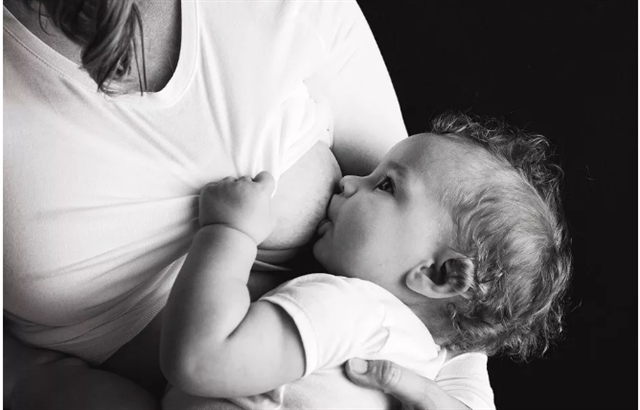母乳喂养或能降低高风险儿童的哮喘患病率
论文标题:The effect of breastfeeding on the risk of asthma in high-risk children: a case-control study in Shanghai, China
期刊:BMC Pregnancy and Childbirth
作者:Xiaona Huo et al
发表时间: 2018/8/23
数字识别码:10.1186/s12884-018-1936-5
原文链接:https://bmcpregnancychildbirth.biomedcentral.com/articles/10.1186/s12884-018-1936-5?utm_source=Other_website&utm_medium=Website_links&utm_content=DaiDen-BMC-BMC_Pregnancy_and_Childbirth-Biology-China&utm_campaign=BMCS_USG_BSCN_DD_BMCPregnancyandchildbirth
最近发表在BMC Pregnancy and Childbirth上的一项研究发现,如果母亲孕期使用过抗生素,孩子患哮喘的风险会升高,但如果母亲能够在孩子出生后的6个月内进行纯母乳喂养,这种风险就会被降低。

研究的通讯作者、上海交通大学医学院附属新华医院张军教授说:“近30年来,儿童哮喘的患病率呈现明显的上升趋势。探索儿童哮喘的病因很重要,但积极寻找有助于预防儿童哮喘发生的保护性因素对改善病人的健康一样重要。此前的研究表明,延长母乳喂养的时间和纯母乳喂养都可能有助于预防儿童过敏性疾病(包括哮喘)的发生,所以我们想要进一步探索母乳喂养在高风险儿童中——尤其是那些母亲孕期使用过抗生素的儿童中——是否也有保护作用。”
研究者们发现,在母亲孕期有过抗生素暴露的孩子患哮喘的几率是没有抗生素暴露的儿童的1.7倍。这其中,男孩和有过敏性疾病家族史的儿童风险尤其高,分别是没有抗生素暴露的儿童的2.2倍和3.1倍。但这种风险只存在于出生后6个月内未给予纯母乳喂养的儿童中,而那些虽然有抗生素暴露但给予纯母乳喂养的儿童并没有表现出额外的哮喘风险。
张教授说:“我们的发现对孕期抗生素的使用有重要的指导意义,同时有助于推动6月龄内婴儿的纯母乳喂养——这一点尤为重要,因为我国目前6月龄内婴儿纯母乳喂养率仍然较低。”
作者们于2015年6月至2016年1日在上海进行了病例对照研究。一共有634名患哮喘的儿童和864名未患哮喘的儿童参与了研究,所有参与儿童均在3-12岁之间。通过对家长进行面对面采访,研究者收集了大量的信息,其中包括孕期抗生素使用情况、孩子出生后6月内的母乳喂养模式和一些基本情况。
作者也提醒,由于本研究是回顾性、观察性的研究,所以不能得出因果性结论。另外,虽然研究者发现母乳喂养有利于改善产前抗生素暴露对儿童哮喘的影响,但这背后的机制尚不明确,还需要进一步的研究。
摘要:
Background
Increasing evidence shows that antibiotic use in pregnancy may increase the risk of childhood asthma but epidemiologic studies are still limited and findings are inconsistent. Meanwhile, exclusive and prolonged breastfeeding may prevent children from allergic diseases. We aimed to assess the association between prenatal antibiotic use and the risk of childhood asthma, and explore whether breastfeeding modifies the risk.
Methods
We conducted a case-control study in Shanghai, China, from June 2015 to January 2016. A total of 634 asthma cases and 864 controls aged 3–12 years were included. Multiple logistic regressions were used to estimate crude and adjusted odds ratios (aOR).
Results
The prevalence of antibiotic use in pregnancy in the cases and controls was 7.1 and 3.5%, respectively. A significant association between prenatal antibiotic use and childhood asthma was observed (aOR: 1.7, 95% CI: 1.0–2.9), particularly in boys (aOR: 2.2, 95% CI: 1.1–4.4) and children with family history of allergic disorders (aOR: 3.1, 95% CI: 1.2–8.4). However, this association existed only in children who were not breastfed exclusively in the first six months of life (aOR 2.6, 95% CI 1.3–5.1) but not in children who were exclusively breastfed (aOR 0.9, 95% CI 0.4–2.1). Likewise, exclusive breastfeeding also decreased the association between antibiotic use in pregnancy and asthma in boys and in children with family histories of allergic diseases.
Conclusions
Antibiotic use in pregnancy was a risk factor for childhood asthma. However, this risk may be attenuated by exclusive breastfeeding in the first six months of life, especially among high-risk children.
阅读论文原文,请访问
https://bmcpregnancychildbirth.biomedcentral.com/articles/10.1186/s12884-018-1936-5?utm_source=Other_website&utm_medium=Website_links&utm_content=DaiDen-BMC-BMC_Pregnancy_and_Childbirth-Biology-China&utm_campaign=BMCS_USG_BSCN_DD_BMCPregnancyandchildbirth
母乳喂养或能降低高风险儿童的哮喘患病率
发布日期:2019-06-07 来源:网络整理 浏览量:
次
最新新闻
热门新闻